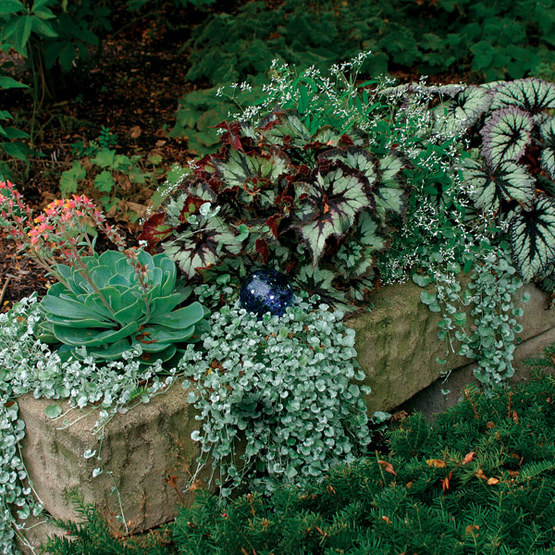
The fabulous foliage of Rex begonias (Begonia Rex-cultorum group) offers a large range of colors, shapes, and textures. The flowers are insignificant, but with leaves like these, who cares? Rex begonias headline the show for months on end in any shade garden, especially when grown in containers. These plants prefer shaded, humid conditions and rich, aerated soil like that found on the forest floor. Too much water and fertilizer is the kiss of death for Rex begonias. Soggy soil and prolonged wet leaves and stems can lead to rot, while highly concentrated fertilizer will burn the foliage. If you keep these points in mind when caring for your plants, it will be smooth sailing.
With all the breeding that has gone on with Rex begonias, it’s hard not to find one that strikes your fancy, especially as more and more selections are being introduced with a wide range of colors and intriguing veining and puckering in the leaves. The leaf sizes vary but grow up to 9 inches long and 5 inches wide, while the mounding habit of the plants generally reaches 12 to 18 inches tall and wide—the perfect proportions to create gorgeous and dramatic planting combinations with perennials, annuals, or other tropical beauties. Use Rex begonias as the heart of vignettes, playing off their intricate colors and details. I think you’ll find it won’t be long before the love of begonias is in your blood, too.
More Reading
If you grow Rex begonias in containers then you might also enjoy these articles.
A Basic Potting Soil Recipe
Get Full, Lush Container Plantings
Three Ways to Design with Containers
Begonia ‘Fireworks’
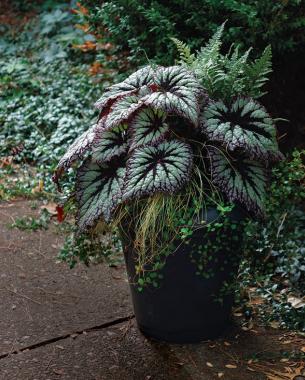
The strong dark black, metallic silver, and vivid purple coloration of ‘Fireworks’ makes it one of the most striking and popular of the new cultivars available. Choosing companion plants that echo these rich colors results in an eye-catching combination.
Good bedfellows
1. Silver dichondra (Dichondra argentea ‘Silver Falls’, USDA Hardiness Zones 10–11)
2. Black mondo grass (Ophiopogon planiscapus ‘Nigrescens’, Z 6–11)
3. Summer Wave® Blue wishbone flower (Torenia ‘SUNrenilabu’, Z 10–11)
Begonia ‘River Nile’
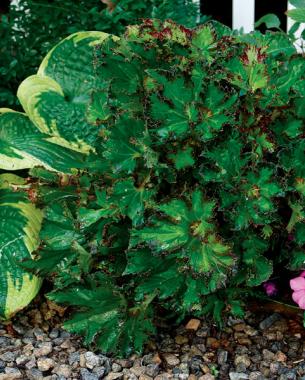
The phrase “less is more” couldn’t ring more true than when it comes to describing ‘River Nile’. There are no flashy colors here. I think you’ll find, however, that the ruffled, luscious green leaves edged in deep bronze are all you need to create dramatic displays centered around this simple color scheme.
Good bedfellows
1. Dwarf elephant’s ear (Colocasia affinis var. jenningsii, Zones 9–11)
2. Fiber-optic grass(Isolepis cernua, Z 8–10)
3. Friendship plant (Pilea involucrata, Z 11)
Rex Begonia
Begonia Rex-cultorum group, (bah-GO-nyah)
Origin: The initial species, B. rex, originated in the forests of northern India. Today, there are countless cultivars derived from this species enjoyed around the world.
Conditions: Considered perennials in tropical and semitropical climates, Rex begonias are frost tender and typically grown as annuals or houseplants in North America. They thrive in organic, sharp-draining soil and in shade with lots of humidity.
Care: Watering “on demand” (or when the soil is dry to the touch) is a great way to keep Rex begonias happy. Avoid soggy conditions, but do not allow plants to wilt. Give Rex begonias a diluted dose of organic, soluble food every four to six weeks during the growing season. Begonias do not grow or use fertilizer efficiently below 58°F.
Overwintering: Rex begonias make excellent houseplants and can easily be overwintered indoors. To supply plants with adequate humidity, place containers on a tray of gravel, where runoff water may collect, evaporate, and raise the air-moisture level. Avoid placing plants near drafts.
Propagation: Although it can take up to six months to produce a new plant, leaf cutting is the most common form of propagation because leaves are the most readily available part of the plant. Seed can take an equally long time and leads to plant variability. You can harvest stems for cuttings; they typically root in about 20 days in favorable conditions.
Begonia ‘Cowardly Lion’
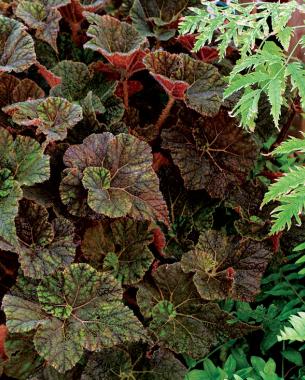
The rich, warm tones of ‘Cowardly Lion’ are a breath of fresh air when compared to the typical cool, blue tones often present in many shade garden plants. Its stunning chocolate-colored leaf veins veil the golden leaves, which become darker with age and make a picture-perfect foil for yellow-based foliage companions.
Good bedfellows
1. Golden St. John’s wort(Hypericum calycinum ‘Briggadoon’, Zones 5–9)
2. ‘Persian Chocolate’ moneywort (Lysimachia congestiflora ‘Persian Chocolate’, Z 6–9)
3. Rita’s Gold™ Boston fern (Nephrolepis exaltata Rita’s Gold™, Z 9–11)
Begonia ‘Green Gold’

‘Green Gold’ is a vigorous oldie but goodie with striking, predominantly silver leaves and deep green veining. New leaves project a warm golden glow and are outlined with a delicate burgundy edging. The silver color brightens up shady nooks and plays nicely with others.
Good bedfellows
1. ‘Lime Rickey’ heuchera (Heuchera ‘Lime Rickey’, Zones 4–8)
2. Diamond Frost® euphorbia(Euphorbia ‘Inneuphdia’, Z 10–11)
3. Golden creeping Jenny (Lysimachia nummularia ‘Aurea’, Z 4–8)
Begonia ‘Stained Glass’
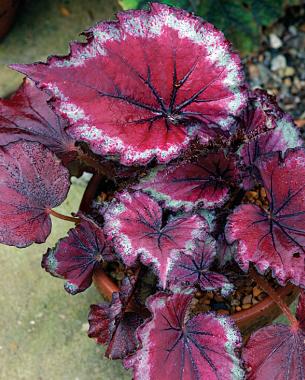
It’s love at first sight when gardeners come across ‘Stained Glass’. Its eye-popping, ruby red leaves are loosely rimmed in pewter with a dollop of dark veining at the center. While there are many ways to play off the colors of this cultivar, the rosy underside of its leaves practically screams out, “Put me with something pink!”
Good bedfellows
1. Infinity® Pink New Guinea impatiens (Impatiens hawkeri ‘Visinfpink’, annual)
2. ‘Dark Star’ coleus (Solenostemon scutellarioides ‘Dark Star’, Zone 11)
3. Tradescantia (Tradescantia zebrina, Z 11)
Begonia ‘Marmaduke’
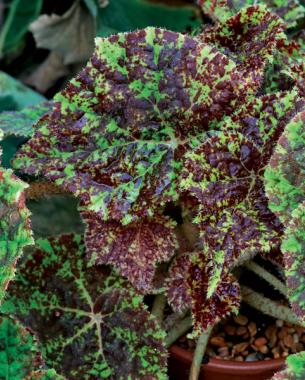
‘Marmaduke’ has the same coloring as ‘Cowardly Lion’ only with a twist. The chocolate-colored tones are speckled across the golden leaves, rather than following the veins. The effect is mesmerizing, and the rich earth tones combine well with solid-colored foliage plants and yellow or rusty-hued blooms.
Good bedfellows
1. Bowles’ golden sedge (Carex elata ‘Aurea’, Zones 5–9)
2. ‘Jungle Gold’ impatiens(Impatiens auricoma ‘Jungle Gold’, annual)
3. ‘Sedona’ coleus (Solenostemon scutellarioides ‘Sedona’, Z 11)
The wide world of begonias
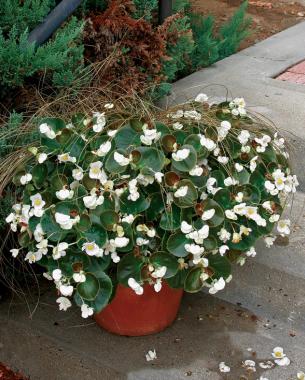
Photo/Illustration: Michelle Gervais
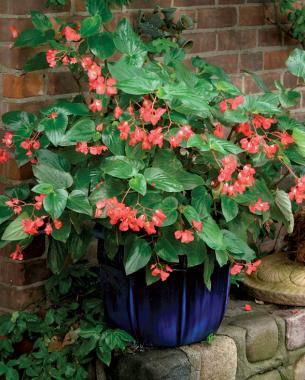
Photo/Illustration: Michelle Gervais
The genus Begonia includes more than 1,300 species and countless hybrids, mutations, and opportune seedlings, which are broken into several classes according to their general appearance and similar culture. Originally, there were only four accepted classes; there are now eight clearly distinct groups. For more information on begonias, visit the Web site of the American Begonia Society, www.begonias.org.
Semperflorens: This group is probably the most commonly known in the world. Often called “wax” or “bedding” begonias, these plants are constant bloomers with round, shiny leaves that are usually green or brown. There are a few variegated varieties.
Canes: These begonias have tough, elongated stems with a bamboolike appearance. Your grandparent called them “angel wings” because of their recognizable wing-shaped leaves.
Shrubs: Whether they are miniature or giant, these bushy, multistemmed types are easy to grow. Many plants in this class have hairy stems or felted leaves.
Rhizomatous: Grown for their showy leaves, these begonias are heavy spring bloomers. They do not get very tall because they grow from creeping rhizomes. The extensive variety of leaf shapes makes them popular with collectors.
Tuberous: These begonias are usually grown for their showy flowers, which come in every color except blue. They vary in size and go dormant in the fall and winter months and restart each spring.
Rex: Famous for their outstanding foliage, color, and texture, Rex begonias are actually a type of rhizomatous begonia. With hundreds of cultivars bred for foliage, flowers are secondary compared to the bold leaves.
Trailing/Scandent: Usually grown in hanging baskets, this class has telltale glossy leaves and pendulous flowers.
Thick-stemmed: Not widely grown, these begonias have large fleshy stems and an upright habit.
Begonia ‘Escargot’
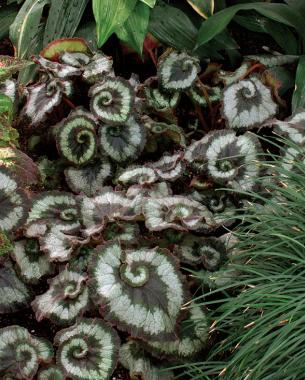
‘Escargot’ is an extremely popular Rex hybrid that is quickly becoming a household name. Its moniker reflects the snail-shaped curl located where the base of the leaf meets the petiole (leaf stem). The intriguing foliage can stand on its own but also mingles beautifully with other foliage plants and brightly colored blooms.
Good bedfellows
1. ‘Green Spice’ heuchera(Heuchera ‘Green Spice’, Zones 4–9)
2. ‘Gartenmeister Bonstedt’ fuchsia (Fuchsia ‘Gartenmeister Bonstedt’, Z 9–10)
3. Purple Swedish ivy (Plectranthus purpuratus, Z 9–11)




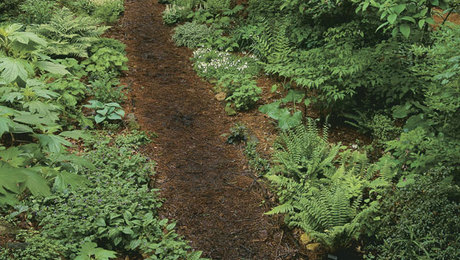













Comments
Log in or create an account to post a comment.
Sign up Log in